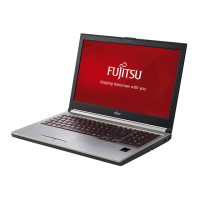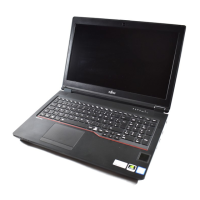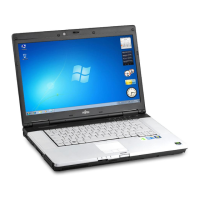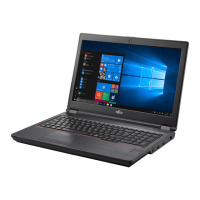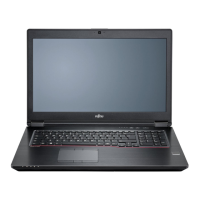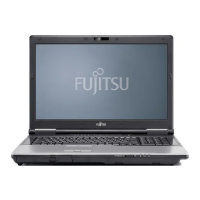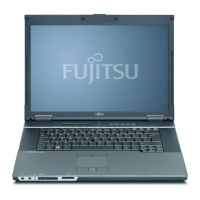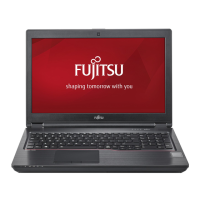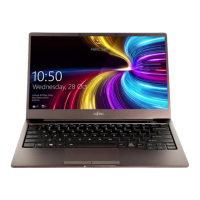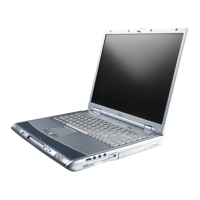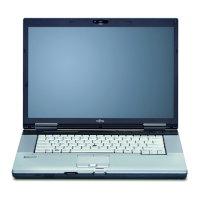Do you have a question about the Fujitsu CELSIUS H720 and is the answer not in the manual?
Provides information on where to find drivers and software updates for the device.
Explains the meaning of symbols and text formatting used in the manual.
Overviews the device's indicators and ports, including diagrams and labels.
Provides essential safety information and references to other safety guidelines.
Details specific safety precautions for using wireless components.
Explains how to conserve power and extend battery life.
Provides guidelines for safely transporting the notebook to prevent damage.
Offers instructions on how to clean the notebook's exterior and display.
Guides the user through the initial setup process, including software installation.
Instructs on how to unpack and inspect the device for any shipping damage.
Provides advice on choosing a suitable and safe place to set up the notebook.
Details how to connect the mains adapter and power cable for initial setup.
Explains the procedure for powering on the notebook for the very first time.
Explains the meaning of various status lights on the notebook.
Details the steps to power on the notebook.
Provides the correct procedure for shutting down the notebook.
Describes the notebook's keyboard layout and special functions.
Describes the layout and use of the separate numeric keypad.
Lists and explains various key combinations for shortcuts and functions.
Guides on how to change regional and keyboard input settings.
Introduces the programmable application keys and their functions.
Explains how to customize the functions assigned to the application keys.
Details how to use the touchpad and its buttons for navigation and selection.
Explains how to move the cursor using the touchpad or TouchStick.
Describes how to select items using the touchpad or buttons.
Explains how to execute commands using the touchpad or buttons.
Guides on how to drag and drop items using the touchpad.
Provides details about the notebook's LCD display, resolution, and pixel information.
Describes the integrated webcam, its usage, and quality factors.
Provides general information about the notebook's rechargeable battery and its lifespan.
Offers guidance on charging, proper care, and maintenance of the battery.
Details the procedure for removing and installing the notebook's battery.
Step-by-step instructions for safely removing the notebook battery.
Step-by-step instructions for safely installing the notebook battery.
Explains the module bay and the types of modules that can be used.
Provides instructions for removing a module from the module bay.
Provides instructions for installing a module into the module bay.
Details the optical drive and its laser classification.
Offers guidelines for handling CDs, DVDs, and other data carriers.
Explains the indicator light for the CD/DVD drive and its meanings.
Guides on how to insert and remove data carriers from the optical drive.
Describes how to manually eject a data carrier in case of power failure.
Provides instructions for removing and cleaning the ventilation slot cover.
Explains how to use power-saving features to conserve energy and battery life.
Details the types of memory cards supported and how to insert/remove them.
Lists the memory card formats compatible with the notebook.
Provides step-by-step instructions for inserting a memory card.
Provides step-by-step instructions for safely removing a memory card.
Describes the ExpressCard slot and the procedure for installing/removing cards.
Guides on inserting an ExpressCard and reinstalling the placeholder.
Guides on safely removing an ExpressCard.
Provides information on the location and use of speakers and microphones.
Explains the use of SIM cards and how to insert/remove them.
Provides instructions for inserting a SIM card into the battery compartment.
Provides instructions for removing a SIM card from the battery compartment.
Covers wireless communication features and their installation.
Details how to enable or disable wireless features like WLAN and Bluetooth.
Guides on configuring wireless network access.
Explains how to connect to the internet using UMTS/LTE mobile networks.
Describes how to connect to a local area network using Ethernet.
Introduces the optional Port Replicator for expanding connectivity.
Details the various ports available on the Port Replicator.
Guides on docking the notebook with the Port Replicator.
Explains how to connect the power supply to the Port Replicator.
Details how to power on the notebook when connected to the Port Replicator.
Details how to shut down the notebook when connected to the Port Replicator.
Guides on safely undocking the notebook from the Port Replicator.
Overview of security features to protect the system from unauthorized access.
Explains how to set up and use the fingerprint sensor for authentication.
Details how to use the Kensington Security Lock to prevent theft.
Guides on setting up password protection within the BIOS Setup Utility.
Explains how to set supervisor and user passwords for BIOS protection.
Step-by-step guide to setting up BIOS supervisor and user passwords.
Instructions for modifying existing BIOS supervisor or user passwords.
Details the process for removing BIOS passwords.
Explains how to use BIOS passwords to prevent unauthorized OS booting.
Steps to enable password protection for the operating system boot.
Steps to disable password protection for the operating system boot.
Details how to enable and disable password protection for the hard disk.
Steps to set up password protection for the hard disk drive.
Steps to remove password protection from the hard disk drive.
Explains BIOS settings for booting from external media.
How to set owner information displayed during boot-up.
Describes the BIOS virus warning feature and its configuration.
Details the SmartCard reader and its usage for security and other functions.
Provides instructions for inserting a SmartCard into the reader.
Explains how to enable and disable the Trusted Platform Module (TPM).
Steps to activate the TPM security chip in BIOS.
Steps to deactivate the TPM security chip in BIOS.
General guidelines and safety precautions for connecting external peripherals.
Details how to connect external monitors via VGA, DisplayPort, or DVI-D.
Explains how to connect devices to the notebook's serial port.
Information on changing serial port configurations in BIOS.
Discusses the need for and installation of drivers for serial port devices.
Guides on connecting USB devices, including hot-plugging and speeds.
Explains that USB devices are automatically recognized and installed.
Details how to connect an external SATA hard disk via the eSATA port.
Provides instructions for safely disconnecting eSATA and USB devices.
Explains how to connect microphones and headphones/speakers.
Details connecting an external microphone or audio input device.
Guides on connecting headphones or external loudspeakers.
General precautions for working with internal components, including ESD.
Steps to take before removing or changing any system components.
Instructions for adding or replacing RAM modules.
Steps to remove the notebook's outer casing.
Detailed steps for removing RAM modules from the notebook.
Detailed steps for installing RAM modules into the notebook.
Steps to reattach the notebook's outer casing after component replacement.
Provides instructions for removing and installing the hard disk drive.
Steps to remove the cover to access the hard disk drive.
Detailed steps for removing the hard disk drive.
Detailed steps for installing a new hard disk drive.
Steps to reattach the cover after hard disk replacement.
Final steps to complete component replacement and prepare for operation.
Explains how to configure system functions and hardware settings via BIOS.
Guides on how to access the BIOS Setup Utility during system startup.
Details how to navigate and use the BIOS Setup Utility interface.
Explains options for saving or discarding changes and exiting BIOS Setup.
How to save current settings and exit the BIOS Setup Utility.
How to exit BIOS Setup without saving any changes.
How to restore factory default settings in BIOS.
How to discard recent changes without exiting BIOS Setup.
How to save changes without exiting BIOS Setup.
How to save changes and then shut down the notebook.
Provides guidance on resolving common hardware and software issues.
Instructions on what to do if you encounter an unresolved problem.
Guides on reinstalling the operating system and drivers.
Troubleshooting steps for incorrect system date and time.
Troubleshooting steps for a blank or unresponsive notebook LCD screen.
Troubleshooting steps for LCD screen readability issues, like glare.
Troubleshooting steps for a blank external monitor.
Troubleshooting steps for external monitor display issues.
Troubleshooting steps for when the notebook fails to power on.
Troubleshooting steps for when the notebook becomes unresponsive.
Troubleshooting steps for printer connectivity and functionality issues.
Troubleshooting steps for wireless network connection failures.
Explains the meaning of acoustic warnings, like low battery.
Lists common BIOS error messages and their resolutions.
Provides detailed technical specifications for the notebook hardware.
Lists the technical specifications for the rechargeable battery.
Lists the technical specifications for the 150W mains adapter.
Lists the technical specifications for the optional Port Replicator.
Information regarding Energy Star certification and power management settings.
Information on how to dispose of and recycle the notebook.
Provides information on compliance with regulatory standards and directives.
Details CE marking requirements for devices with radio components.
Provides general regulatory information and notices.
Regulatory information specific to notebooks that do not have radio devices.
FCC compliance statement for digital devices.
Details FCC limits for Class B digital devices and interference resolution.
Information on RF exposure limits and compliance for radio devices.
General regulatory notes and statements regarding radio devices.
Information on the safety and authorized use of radio devices.
Disclaimers and information on installation and use of radio devices.
Information on export restrictions for products with encryption code.
Provides information on where to find drivers and software updates for the device.
Explains the meaning of symbols and text formatting used in the manual.
Overviews the device's indicators and ports, including diagrams and labels.
Provides essential safety information and references to other safety guidelines.
Details specific safety precautions for using wireless components.
Explains how to conserve power and extend battery life.
Provides guidelines for safely transporting the notebook to prevent damage.
Offers instructions on how to clean the notebook's exterior and display.
Guides the user through the initial setup process, including software installation.
Instructs on how to unpack and inspect the device for any shipping damage.
Provides advice on choosing a suitable and safe place to set up the notebook.
Details how to connect the mains adapter and power cable for initial setup.
Explains the procedure for powering on the notebook for the very first time.
Explains the meaning of various status lights on the notebook.
Details the steps to power on the notebook.
Provides the correct procedure for shutting down the notebook.
Describes the notebook's keyboard layout and special functions.
Describes the layout and use of the separate numeric keypad.
Lists and explains various key combinations for shortcuts and functions.
Guides on how to change regional and keyboard input settings.
Introduces the programmable application keys and their functions.
Explains how to customize the functions assigned to the application keys.
Details how to use the touchpad and its buttons for navigation and selection.
Explains how to move the cursor using the touchpad or TouchStick.
Describes how to select items using the touchpad or buttons.
Explains how to execute commands using the touchpad or buttons.
Guides on how to drag and drop items using the touchpad.
Provides details about the notebook's LCD display, resolution, and pixel information.
Describes the integrated webcam, its usage, and quality factors.
Provides general information about the notebook's rechargeable battery and its lifespan.
Offers guidance on charging, proper care, and maintenance of the battery.
Details the procedure for removing and installing the notebook's battery.
Step-by-step instructions for safely removing the notebook battery.
Step-by-step instructions for safely installing the notebook battery.
Explains the module bay and the types of modules that can be used.
Provides instructions for removing a module from the module bay.
Provides instructions for installing a module into the module bay.
Details the optical drive and its laser classification.
Offers guidelines for handling CDs, DVDs, and other data carriers.
Explains the indicator light for the CD/DVD drive and its meanings.
Guides on how to insert and remove data carriers from the optical drive.
Describes how to manually eject a data carrier in case of power failure.
Provides instructions for removing and cleaning the ventilation slot cover.
Explains how to use power-saving features to conserve energy and battery life.
Details the types of memory cards supported and how to insert/remove them.
Lists the memory card formats compatible with the notebook.
Provides step-by-step instructions for inserting a memory card.
Provides step-by-step instructions for safely removing a memory card.
Describes the ExpressCard slot and the procedure for installing/removing cards.
Guides on inserting an ExpressCard and reinstalling the placeholder.
Guides on safely removing an ExpressCard.
Provides information on the location and use of speakers and microphones.
Explains the use of SIM cards and how to insert/remove them.
Provides instructions for inserting a SIM card into the battery compartment.
Provides instructions for removing a SIM card from the battery compartment.
Covers wireless communication features and their installation.
Details how to enable or disable wireless features like WLAN and Bluetooth.
Guides on configuring wireless network access.
Explains how to connect to the internet using UMTS/LTE mobile networks.
Describes how to connect to a local area network using Ethernet.
Introduces the optional Port Replicator for expanding connectivity.
Details the various ports available on the Port Replicator.
Guides on docking the notebook with the Port Replicator.
Explains how to connect the power supply to the Port Replicator.
Details how to power on the notebook when connected to the Port Replicator.
Details how to shut down the notebook when connected to the Port Replicator.
Guides on safely undocking the notebook from the Port Replicator.
Overview of security features to protect the system from unauthorized access.
Explains how to set up and use the fingerprint sensor for authentication.
Details how to use the Kensington Security Lock to prevent theft.
Guides on setting up password protection within the BIOS Setup Utility.
Explains how to set supervisor and user passwords for BIOS protection.
Step-by-step guide to setting up BIOS supervisor and user passwords.
Instructions for modifying existing BIOS supervisor or user passwords.
Details the process for removing BIOS passwords.
Explains how to use BIOS passwords to prevent unauthorized OS booting.
Steps to enable password protection for the operating system boot.
Steps to disable password protection for the operating system boot.
Details how to enable and disable password protection for the hard disk.
Steps to set up password protection for the hard disk drive.
Steps to remove password protection from the hard disk drive.
Explains BIOS settings for booting from external media.
How to set owner information displayed during boot-up.
Describes the BIOS virus warning feature and its configuration.
Details the SmartCard reader and its usage for security and other functions.
Provides instructions for inserting a SmartCard into the reader.
Explains how to enable and disable the Trusted Platform Module (TPM).
Steps to activate the TPM security chip in BIOS.
Steps to deactivate the TPM security chip in BIOS.
General guidelines and safety precautions for connecting external peripherals.
Details how to connect external monitors via VGA, DisplayPort, or DVI-D.
Explains how to connect devices to the notebook's serial port.
Information on changing serial port configurations in BIOS.
Discusses the need for and installation of drivers for serial port devices.
Guides on connecting USB devices, including hot-plugging and speeds.
Explains that USB devices are automatically recognized and installed.
Details how to connect an external SATA hard disk via the eSATA port.
Provides instructions for safely disconnecting eSATA and USB devices.
Explains how to connect microphones and headphones/speakers.
Details connecting an external microphone or audio input device.
Guides on connecting headphones or external loudspeakers.
General precautions for working with internal components, including ESD.
Steps to take before removing or changing any system components.
Instructions for adding or replacing RAM modules.
Steps to remove the notebook's outer casing.
Detailed steps for removing RAM modules from the notebook.
Detailed steps for installing RAM modules into the notebook.
Steps to reattach the notebook's outer casing after component replacement.
Provides instructions for removing and installing the hard disk drive.
Steps to remove the cover to access the hard disk drive.
Detailed steps for removing the hard disk drive.
Detailed steps for installing a new hard disk drive.
Steps to reattach the cover after hard disk replacement.
Final steps to complete component replacement and prepare for operation.
Explains how to configure system functions and hardware settings via BIOS.
Guides on how to access the BIOS Setup Utility during system startup.
Details how to navigate and use the BIOS Setup Utility interface.
Explains options for saving or discarding changes and exiting BIOS Setup.
How to save current settings and exit the BIOS Setup Utility.
How to exit BIOS Setup without saving any changes.
How to restore factory default settings in BIOS.
How to discard recent changes without exiting BIOS Setup.
How to save changes without exiting BIOS Setup.
How to save changes and then shut down the notebook.
Provides guidance on resolving common hardware and software issues.
Instructions on what to do if you encounter an unresolved problem.
Guides on reinstalling the operating system and drivers.
Troubleshooting steps for incorrect system date and time.
Troubleshooting steps for a blank or unresponsive notebook LCD screen.
Troubleshooting steps for LCD screen readability issues, like glare.
Troubleshooting steps for a blank external monitor.
Troubleshooting steps for external monitor display issues.
Troubleshooting steps for when the notebook fails to power on.
Troubleshooting steps for when the notebook becomes unresponsive.
Troubleshooting steps for printer connectivity and functionality issues.
Troubleshooting steps for wireless network connection failures.
Explains the meaning of acoustic warnings, like low battery.
Lists common BIOS error messages and their resolutions.
Provides detailed technical specifications for the notebook hardware.
Lists the technical specifications for the rechargeable battery.
Lists the technical specifications for the 150W mains adapter.
Lists the technical specifications for the optional Port Replicator.
Information regarding Energy Star certification and power management settings.
Information on how to dispose of and recycle the notebook.
Provides information on compliance with regulatory standards and directives.
Details CE marking requirements for devices with radio components.
Provides general regulatory information and notices.
Regulatory information specific to notebooks that do not have radio devices.
FCC compliance statement for digital devices.
Details FCC limits for Class B digital devices and interference resolution.
Information on RF exposure limits and compliance for radio devices.
General regulatory notes and statements regarding radio devices.
Information on the safety and authorized use of radio devices.
Disclaimers and information on installation and use of radio devices.
Information on export restrictions for products with encryption code.
| Chipset | Intel QM77 |
|---|---|
| Optical drive | DVD Super Multi |
| Processor | Intel Core i7-3720QM |
| RAM | 16 GB |
| Storage | 256 GB SSD |
| Display | 15.6-inch, Full HD (1920x1080) |
| Graphics | NVIDIA Quadro K1000M |
| Operating System | Windows 7 Professional |
| Battery | 6-cell Lithium-Ion |
